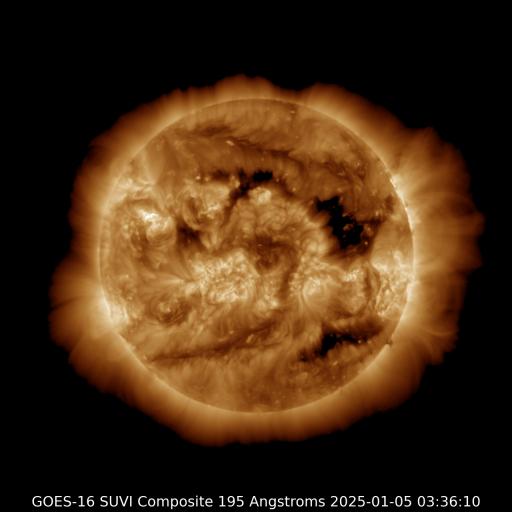Viewing archive of Sunday, 17 June 2018
Daily bulletin on solar and geomagnetic activity from the SIDC
Issued: 2018 Jun 17 1230 UTC
SIDC Forecast
Solar flares
Quiet conditions (<50% probability of C-class flares)
Geomagnetism
Quiet (A<20 and K<4)
Solar protons
Quiet
| 10cm flux | Ap | |
|---|---|---|
| 17 Jun 2018 | 071 | 007 |
| 18 Jun 2018 | 071 | 010 |
| 19 Jun 2018 | 071 | 016 |
Bulletin
Solar activity was very low with X-ray flux remaining below B level. Catania sunspot group 86 (NOAA active region 2713) almost fully decayed. Chances for C class flaring remain very low.
No Earth directed CMEs were observed in coronagraph images.
Solar proton flux levels were at background values and are expected to remain so.
Solar wind conditions have been nominal with solar wind speed around 300 km/s and total magnetic field below 5 nT. The Bz component of the magnetic field was variable. The magnetic field phi angle indicates a negative sector connection. Solar wind conditions are expected to remain nominal in the next 24 hours with afterwards an expected sector change and a moderate increase in solar wind speed associated to the positive polarity coronal hole in the northern hemisphere that has passed the central meridian June 14-15.
Geomagnetic conditions were quiet to unsettled (local K Dourbes 0-3 and NOAA Kp 0-1) and are expected to first be quiet and later quiet to unsettled as solar wind speed becomes slightly increased.
Today's estimated international sunspot number (ISN): 014, based on 11 stations.Solar indices for 16 Jun 2018
| Wolf number Catania | /// |
| 10cm solar flux | 071 |
| AK Chambon La Forêt | 006 |
| AK Wingst | /// |
| Estimated Ap | 003 |
| Estimated international sunspot number | 015 - Based on 21 stations |
Noticeable events summary
| Day | Begin | Max | End | Loc | Strength | OP | 10cm | Catania/NOAA | Radio burst types | |
|---|---|---|---|---|---|---|---|---|---|---|
| None | ||||||||||
Provided by the Solar Influences Data analysis Center© - SIDC - Processed by SpaceWeatherLive
All times in UTC
Current data suggests there is a moderate possibility for aurora to appear at the following high latitude regions in the near future
Gillam, MB, Yellowknife, NTCurrent data suggests there is a slight possibility for aurora to appear at the following high latitude regions in the near future
Edmonton, AB, Iqaluit, NU, Saskatoon, SKNuuk
Juneau, AK
Latest news
Latest forum messages
Support SpaceWeatherLive.com!
A lot of people come to SpaceWeatherLive to follow the Sun's activity or if there is aurora to be seen, but with more traffic comes higher server costs. Consider a donation if you enjoy SpaceWeatherLive so we can keep the website online!

Latest alerts
05:15 UTC - Hemispheric Power Index
The OVATION model predicts the Hemispheric Power Index to reach 50GW at 06:02 UTC
00:55 UTC - Coronal hole
A southern hemisphere coronal hole is facing Earth. Enhanced solar wind could arrive in ~3 days
Monday, 7 April 2025
20:45 UTC - Geomagnetic activity
Active geomagnetic conditions (Kp4) Threshold Reached: 20:39 UTC
17:33 UTC - Hemispheric Power Index
The OVATION model predicts the Hemispheric Power Index to reach 51GW at 18:18 UTC
Space weather facts
| Last X-flare | 2025/03/28 | X1.1 |
| Last M-flare | 2025/04/05 | M1.0 |
| Last geomagnetic storm | 2025/04/06 | Kp5 (G1) |
| Spotless days | |
|---|---|
| Last spotless day | 2022/06/08 |
| Monthly mean Sunspot Number | |
|---|---|
| March 2025 | 134.2 -20.4 |
| April 2025 | 151.3 +17.1 |
| Last 30 days | 135.2 -4.5 |




